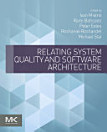The Process of Software Architecting
Peter Eeles · Peter Cripps
জুলাই ২০০৯ · Pearson Education
৩.৭star
৩ টা পৰ্যালোচনাreport
ইবুক
432
পৃষ্ঠা
family_home
যোগ্য
info
reportমূল্যাংকন আৰু পৰ্যালোচনা সত্যাপন কৰা হোৱা নাই অধিক জানক
এই ইবুকখনৰ বিষয়ে
A Comprehensive Process for Defining Software Architectures That Work
A good software architecture is the foundation of any successful software system. Effective architecting requires a clear understanding of organizational roles, artifacts, activities performed, and the optimal sequence for performing those activities.
With The Process of Software Architecting, Peter Eeles and Peter Cripps provide guidance on these challenges by covering all aspects of architecting a software system, introducing best-practice techniques that apply in every environment, whether based on Java EE, Microsoft .NET, or other technologies. Eeles and Cripps first illuminate concepts related to software architecture, including architecture documentation and reusable assets. Next, they present an accessible, task-focused guided tour through a typical project, focusing on the architect’s role, with common issues illuminated and addressed throughout. Finally, they conclude with a set of best practices that can be applied to today’s most complex systems.
You will come away from this book understanding
A good software architecture is the foundation of any successful software system. Effective architecting requires a clear understanding of organizational roles, artifacts, activities performed, and the optimal sequence for performing those activities.
With The Process of Software Architecting, Peter Eeles and Peter Cripps provide guidance on these challenges by covering all aspects of architecting a software system, introducing best-practice techniques that apply in every environment, whether based on Java EE, Microsoft .NET, or other technologies. Eeles and Cripps first illuminate concepts related to software architecture, including architecture documentation and reusable assets. Next, they present an accessible, task-focused guided tour through a typical project, focusing on the architect’s role, with common issues illuminated and addressed throughout. Finally, they conclude with a set of best practices that can be applied to today’s most complex systems.
You will come away from this book understanding
- The role of the architect in a typical software development project
- How to document a software architecture to satisfy the needs of different stakeholders
- The applicability of reusable assets in the process of architecting
- The role of the architect with respect to requirements definition
- The derivation of an architecture based on a set of requirements
- The relevance of architecting in creating complex systems
মূল্যাংকন আৰু পৰ্যালোচনাসমূহ
৩.৭
৩ টা পৰ্যালোচনা
লিখকৰ বিষয়ে
Peter Eeles is an IBM executive IT architect, working within the Rational brand of IBM’s Software Group. In this capacity he helps organizations improve their software development capability, with a particular focus on and interest in improving the architecting process. Peter has been in the software industry since 1985 and has spent much of his career architecting and implementing large-scale, distributed systems. Peter is coauthor of Building J2EE Applications with the Rational Unified Process (Addison-Wesley, 2002) and coauthor of Building Business Objects (John Wiley & Sons, 1998). He is a fellow of the British Computer Society (FBCS), a fellow of the Institute of Engineering and Technology (FIET), an IBM technical staff member, an Open Group Master Certified IT architect, and a Chartered IT Professional (CITP).
Peter Cripps is an IT architect in IBM Global Business Services in the United Kingdom. He has been in the software industry since 1980, during which time he has worked as a programmer, real-time software engineer, and process engineer across a range of industries, including telecommunications, financial services, retail, and government. Peter’s particular areas of technical expertise and interest are the application of component- and service-based development techniques and the development of good architecture practice. He is a member of the British Computer Society (MBCS) and a Chartered IT Professional (CITP).
Peter Cripps is an IT architect in IBM Global Business Services in the United Kingdom. He has been in the software industry since 1980, during which time he has worked as a programmer, real-time software engineer, and process engineer across a range of industries, including telecommunications, financial services, retail, and government. Peter’s particular areas of technical expertise and interest are the application of component- and service-based development techniques and the development of good architecture practice. He is a member of the British Computer Society (MBCS) and a Chartered IT Professional (CITP).
এই ইবুকখনক মূল্যাংকন কৰক
আমাক আপোনাৰ মতামত জনাওক।
পঢ়াৰ নির্দেশাৱলী
স্মাৰ্টফ’ন আৰু টেবলেট
Android আৰু iPad/iPhoneৰ বাবে Google Play Books এপটো ইনষ্টল কৰক। ই স্বয়ংক্রিয়ভাৱে আপোনাৰ একাউণ্টৰ সৈতে ছিংক হয় আৰু আপুনি য'তে নাথাকক ত'তেই কোনো অডিঅ'বুক অনলাইন বা অফলাইনত শুনিবলৈ সুবিধা দিয়ে।
লেপটপ আৰু কম্পিউটাৰ
আপুনি কম্পিউটাৰৰ ৱেব ব্রাউজাৰ ব্যৱহাৰ কৰি Google Playত কিনা অডিঅ'বুকসমূহ শুনিব পাৰে।
ই-ৰীডাৰ আৰু অন্য ডিভাইচ
Kobo eReadersৰ দৰে ই-চিয়াঁহীৰ ডিভাইচসমূহত পঢ়িবলৈ, আপুনি এটা ফাইল ডাউনল’ড কৰি সেইটো আপোনাৰ ডিভাইচলৈ স্থানান্তৰণ কৰিব লাগিব। সমৰ্থিত ই-ৰিডাৰলৈ ফাইলটো কেনেকৈ স্থানান্তৰ কৰিব জানিবলৈ সহায় কেন্দ্ৰত থকা সবিশেষ নিৰ্দেশাৱলী চাওক।




